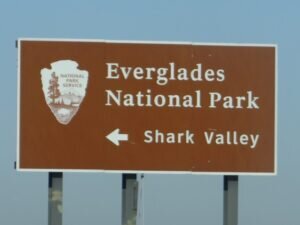Southernmost
“...where the black water rolls and the sawgrass waves...”
By the end of the day, I’d gotten used to seeing alligators. Pedaling along a 15-mile bike loop in the Everglades, I accelerated past a fair number of 6 to 7 footers basking in the sun. Dozens of smaller ones looked out at me from the swamp water with sleepy, half closed eyes. A park ranger had briefed us that the creatures could move fast despite their sluggish looks. Not wanting to get whacked by the business end of a tail or munched for lunch, I gave them wide berth and pedaled as fast as the rusted, coaster brake rental bike would take me. Technically, I had been here before.
Roughly, forever ago, I visited the Everglades with my parents, older sister, and little brother. My takeaway from a child’s perspective was the stifling heat and swatting mosquitos on my bloody legs and arms. Buggy and hot. Somewhere in a box in an attic is the only souvenir of that outing; a black and white photograph of an alligator, taken with my sister’s Brownie camera from so far away the reptile looks like a large, black log on the road.
Path Mere Feet from Water
Creasing the Edges
Decades later, this is a day trip for my husband and me. Ft Lauderdale had been our home the last couple of months, living aboard a boat we bought to travel the Great Loop. Exhausted from endless boat repairs, it was a conversation with another sailor on the dock, a native Floridian, that prompted a visit to the Park. Fire gleamed in his eyes as, sixty something, he stood shirtless wearing shorts and flip flops, recounting the glory days of pot-smuggling in the Glades during the 1980s.
“Back then we called the bales of marijuana “square grouper”. Fortunes were made and lost in a night. I was lucky, but sure creased the edges.”
Land of the Seminole
During the 80s, I was in the Army and more concerned with the Cold War than the war on drugs. But the promise of a day in nature, away from the boat, was what Glen and I craved. Heading south in a rental car, marsh and wetlands filled our view as soon as we departed Ft Lauderdale. Until land developers drained and filled the wetlands, Ft Lauderdale and Miami looked just like that swamp. Until the early 1900s, the Seminoles were the only people in the Everglades. Then, it stretched from what is now Orlando to the southernmost tip of Florida and the Gulf of Mexico. Now the untamed swamp abuts suburbia. But the Glades that remain are unique in all the world and as wild as you could want.
For one, the Everglades is the only place on earth where you can see both alligators and crocodiles. The rare and endangered Florida panther slinks through the sawgrass hunting a species of small, white-tailed deer, wild boar and the occasional young alligator. Nearly 300 species of fish, 360 bird species and more than 700 kinds of plants call its brackish waters home. Besides supporting so much life, entire rivers of water course through the marshes like veins, changing direction twice a day as though breathing with the ocean tides. We walked on patches of what looks and feels like land underfoot, but is really a tangled mat of roots running down to the shifting waterline.
Glen and I just scratched the edges of the 1 million acres that is the Everglades. But we’ll be back. We are piloting our boat to the Keys for the winter, and a channel of skinny water marked by navigational aids looks inviting to explore by kayak or dinghy. Hopefully, the big crocs and gators are content with sunning.




